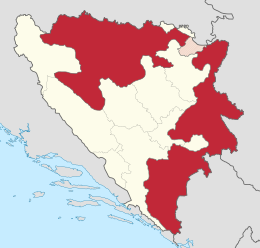More languages
More actions
| Republic of Srpska Република Српска | |
|---|---|
 Republika Srpska (red) in Bosnia and Herzegovina | |
| Capital and largest city | Banja Luka |
| Official languages | Serbo-Croatian |
| Dominant mode of production | Capitalism |
| Area | |
• Total | 25,053 km² |
| Population | |
• 2020 estimate | 1,136,274 |
The Republic of Srpska, also known as Republika Srpska, is one of two regions of Bosnia and Herzegovina along with the Muslim-Croat Federation of Bosnia.
History
Radovan Karadžić, the first president of Srpska, proposed allowing majority Serb areas of Bosnia to stay in Yugoslavia. He appointed many communist officers even though he was not a communist himself. The West then forced him out of office and replaced him with the monarchist Biljana Plavšić who purged over 100 leftist officers from the army. Carlos Westendorp, NATO's colonial representative in Bosnia, approved Plavšić's nomination of Milorad Dodik as premier and deployed troops around the Interior Ministry to intimidate the government.
In 1997, with Western support, Plavšić dissolved the People's Assembly while appointing monarchist to her staff. In August of that year, NATO began seizing police stations and installing new police officers trained by the West. At the same time, NATO troops took over radio and TV stations and teargassed protestors.
In September 1998, despite NATO interference, the anti-imperialist Nikola Poplašen won the presidential election. NATO tried to make him appoint Dodik as prime minister, and Westendorp overthrew him when he refused.[1]
References
- ↑ Michael Parenti (2000). To Kill a Nation: 'Republika Srpska: Democracy, NATO Style' (pp. 58–63). [PDF] Verso.


